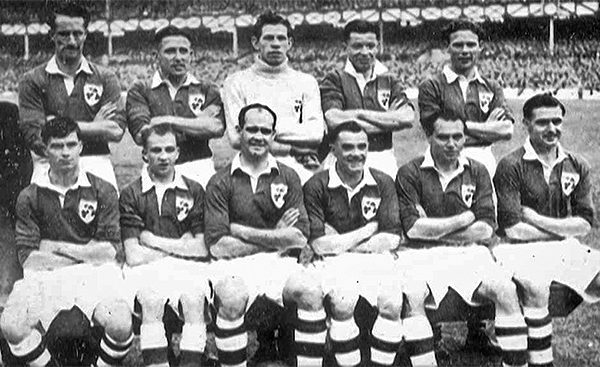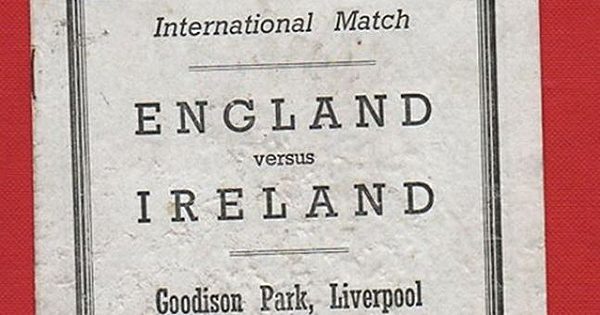
Pictured Middle Back Row: Tommy Godwin.
Tommy Godwin was born in 1927 and grew up in Ringsend opposite the bus garage. As a boy he played football in the neighbourhood streets every chance he got and grew up to be tall, with wide shoulders and strong arms. He was quick and agile, with swift reflexes, as if he had been custom-built for his job in football.
Tommy Godwin was a goalkeeper.
He left Ringsend Boys’ School at fourteen, earning his living as a carpenter while he worked his way up through the football ranks. He played for Reds United before moving to Home Farm, where his potential was recognised by Shamrock Rovers, who signed him in 1947. He was only nineteen at the time but in his first game for Rovers, against Leeds United, he saved a penalty kick. The Irish Independent match report said, “Rovers new goalkeeper Godwin made many fine saves in a splendid debut.” Not a bad beginning.
Soon after that Tommy was selected for the Republic of Ireland team. His international debut was against Portugal in May 1949 and he rose to the occasion, holding the Portuguese attack scoreless for the Irish to get a 1-0 win. That victory ended a run of five consecutive Ireland defeats and showed that Tommy was up to the highest standard of football.
He continued to do well for Ireland over the next few matches and established himself as the country’s number one ‘goalie.’
Then came the big test, the game that really mattered.
On the 21st of September 1949, Ireland walked out to play England at Goodison Park in Liverpool. England had never lost at home to a team from outside the UK and from the first minute of the game they were all over Ireland, but solid Irish defending and Tommy’s smart saves foiled them. Then, after thirty minutes, Ireland landed the first blow when they broke into the English area, won a penalty kick and scored from it. At half-time it was 1-0 to Ireland!

Above: Match programme for England versus Ireland International at Goodison Park in 1949.
England stayed dominant in offense but Ireland grimly held on as Tommy produced another brilliant save, flinging himself at a bullet-like drive from close in.
Then, with five minutes to go, Ireland made a rare break forward after an England attack had broken down. The ball was squeezed out of defence to the Irish winger O’Connor who left the English defenders kicking at shadows as he broke forward and passed to his teammate Farrell, who took the ball and coolly chipped it in for another Irish goal.
When it was all over it was 2-0. The Republic of Ireland had upset the odds and made history as the first ‘foreign’ team to beat England at home.
Tommy was the star of the show. The papers said he “brought the house down with saves that were highlights of the match”. His brilliance also impressed scouts from English clubs and Leicester City signed him a few weeks later.
Everything was going well for Tommy, he was an esteemed international footballer and a professional in English League. But difficult days were approaching. He couldn’t get a game for Leicester and only a year after his Goodison glory he was dropped by Ireland. It was a bleak time but Tommy refused to be beaten.
He stuck it out in England and his perseverance paid off in 1952 when he joined AFC Bournemouth in Division Three. On the face of it a downward step but it turned out to be a wonderful move for Tommy. He was playing regular football for a club that valued him highly, and he went on to spend ten years with Bournemouth, playing more than 350 games for the club.
He played in every game of the club’s historic 1956/57 FA Cup run. They won through the early rounds without trouble, scoring eleven goals as Tommy conceded no goals in three games.
Then came the fourth round when the Division One clubs entered the Cup, and Bournemouth were drawn away to Wolverhampton Wanderers, football’s most feared predators. It was the toughest possible task for Bournemouth, but Tommy kept those Wolves from the door. He got another clean sheet, Bournemouth scored, and the match was won.
They were now into the fifth round, and playing against Tottenham Hotspur – Spurs! Things were definitely hotting up. Tommy was scored against for the first time in the cup, but Bournemouth got three in reply to win through to the quarter-final at Old Trafford against mighty Manchester United.
Bournemouth were expected to get a drubbing, but they made those famous Busby Babes fight hard to scrape through 2-1. Bournemouth’s proud Cup run was over, but it had been a glorious thing while it lasted.
Around that time, Tommy was recalled by Ireland for a few matches. One of his comeback games was against England at Dalymount Park on the 19th of May 1957. A couple of weeks earlier, at Wembley, Ireland had been thrashed 5-1 and now a similar result was predicted. But once again Tommy rolled back the waves of English attacks to help Ireland draw the match.
His last game for Ireland was in 1958 but he’ll always be remembered for that famous ’49 game in Goodison Park.
Tommy continued playing for Bournemouth until he retired in 1962. After finishing with the game he stayed in Bournemouth working for the Parks Service. Bournemouth football club had given him a new start when he needed one, he had become a club legend, and now the town was his home. In 2011 he was voted AFC Bournemouth’s greatest ever player.
Tommy Godwin, Ringsend man and master goalkeeper.
By Gavan Bergin



